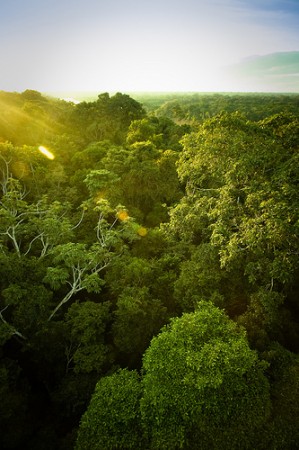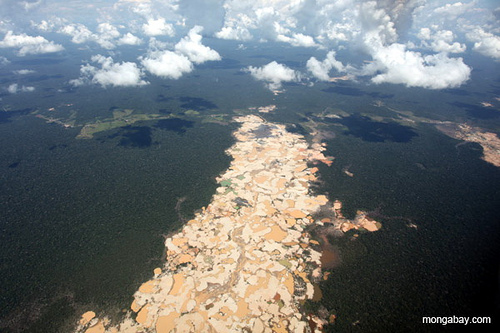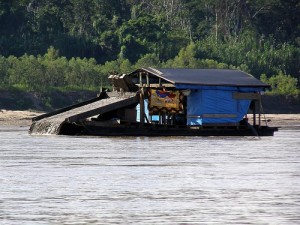 Seventeen years ago, Canadian biologist Adrian Forsyth slipped into lyricism as he described the great wilderness known as Tambopata-Candamo in Peru. The cloud forests there, he wrote in an official report, “are dense with every limb matted with fern, orchid and moss and the only trails are those of the secretive spectacled bear and elusive mountain lion…. Along the banks of the Tambopata brilliant flocks of macaws concentrate by the hundreds to feed on mineral-rich soil pockets. Giant otters hunt the rivers for enormous catfish. Vast expanses of forest extend in all directions.”
Seventeen years ago, Canadian biologist Adrian Forsyth slipped into lyricism as he described the great wilderness known as Tambopata-Candamo in Peru. The cloud forests there, he wrote in an official report, “are dense with every limb matted with fern, orchid and moss and the only trails are those of the secretive spectacled bear and elusive mountain lion…. Along the banks of the Tambopata brilliant flocks of macaws concentrate by the hundreds to feed on mineral-rich soil pockets. Giant otters hunt the rivers for enormous catfish. Vast expanses of forest extend in all directions.”
This untouched paradise lay near the headwaters of the Amazon, and Forsyth and 23 colleagues explored it, charting its biodiversity for Conservation International. (Sadly, two of the CI team died in the line of action, when their small plane crashed in a treetop survey.) But the team persevered, recording 575 bird species and 1200 butterfly species, the second richest documented butterfly community in the world. Their final report pleaded powerfully for the protection of this vast emerald wilderness.
But the key to Tambopata-Condamo’s fate lay in just four words in that 184-page-long report: “mineral-rich soil pockets.” Today, nearly two decades after Forsyth waxed eloquent, steepling gold prices and a government seemingly paralyzed by corruption are transforming part of this paradise—the Madre de Dios river and its surrounding forest—into an ecological disaster on a grand scale. “It looks like Mordor,” said Alex Chepstow-Lusty, a paleoecologist at the French Institute of Andean Studies in Lima, in an interview I did with him in February.
 At that time, an estimated 64,000 migrants worked as illegal gold miners in the region, and many more have arrived since from surrounding regions. The newcomers quickly gravitate to illegal mining camps scattered along the banks of Madre de Dios, where teams operate dredges to scoop up sediments from river bottoms. In large patches of chopped down forest, the miners sluice the sludge to retrieve sand with golden flecks.
At that time, an estimated 64,000 migrants worked as illegal gold miners in the region, and many more have arrived since from surrounding regions. The newcomers quickly gravitate to illegal mining camps scattered along the banks of Madre de Dios, where teams operate dredges to scoop up sediments from river bottoms. In large patches of chopped down forest, the miners sluice the sludge to retrieve sand with golden flecks.
Then the really dirty work begins. The miners empty buckets of the sparkly sand into barrels and mix in mercury, stamping barefoot on the toxic mixture as if it were grapes in a winery. Satisfied, they cook the amalgam with a blowtorch until much of the mercury vaporizes. The resulting gold “sponge” can then be sold in neighboring towns. For this poisonous work, an unskilled labourer can pocket some $184 a day – a princely sum in a country where most unskilled workers scrape by on just $100 a month.
The international press has paid relatively little attention to this disaster. The area is lawless and some observers speculate that Peru’s cocaine traffickers are financing the larger operations. Human traffickers are bringing in children to work in brothels in the area. It’s a place where an inquisitive reporter could disappear very easily. But Lima-based journalist Barbara Fraser has stuck to the story, chronicling the resulting environmental tragedy. In Environmental Science Technology in 2009, she described the effect of this industry on the rivers and forests of the region:
Mercury entered the environment at various points in the process. Residual mercury in the sand that is discarded after amalgamation can wash into rivers or streams; there bacteria convert the mercury into methyl mercury, which bioaccumulates in fauna, especially piscivorous fish and mammals higher up the food chain. Mercury vapor released when the amalgam is heated can be inhaled, the most dangerous exposure route for humans, or precipitates out and settles on streets or watersheds.
 The Peruvian government finally took some action in February, sending in its armed forces to crack down on the illegal mining operations. According to a government spokesperson, the military burned and destroyed at least 19 illegal dredgers operating along Madre de Dios. But environmentalists are far from sanguine about the future prospects. Peruvians elected a new government this past summer, and in early October one of its leading members Amado Romero was charged with “environmental crimes,” stemming from his own illegal mining operations.
The Peruvian government finally took some action in February, sending in its armed forces to crack down on the illegal mining operations. According to a government spokesperson, the military burned and destroyed at least 19 illegal dredgers operating along Madre de Dios. But environmentalists are far from sanguine about the future prospects. Peruvians elected a new government this past summer, and in early October one of its leading members Amado Romero was charged with “environmental crimes,” stemming from his own illegal mining operations.
It’s clearly a mess, an almost mythical paradise near the headwaters of the Amazon transformed into a toxic waste site. And perhaps you are wondering what any of this has to do with Black Friday. Well if you are not out fighting for elbow space in the shopping mobs, perhaps you are drawing up a gift list or two. And if you are contemplating picking up a pair of gold earrings for your mother or a gold ring for your significant other, you might want to give that a little more thought. Oxfam and Earthworks are now collaborating on a No Dirty Gold campaign. As part of this, the agencies have drawn up a list of retailers–from Target to Tiffany & Co–who are now actively pursuing clean and ethical sources of gold for their jewelry.
Photos: Upper: Tambopata, courtesy Dirac 3000. Middle: Illegal gold mine established in 2009 in Madre de Dios, courtesy Rhett Butler. Lower: Gold mining operation, courtesy Druid labs.
I’ve seen this for myself back in the eighties in Brazil. My father actually mined gold there, and it’s a filthy business, filled with people who couldn’t care less what damage they do.
Ever heard of gold fever? It really exists, and unfortunately the environment is what suffers most.
Bella: I remember reading about those miners in Brazil at the time. I sure hope your father did not suffer any adverse health affects from this dangerous type of mining.